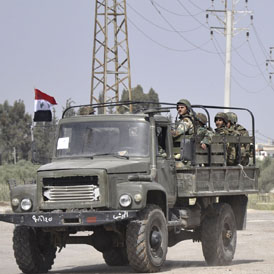Syria’s army holds the key to Assad regime’s future
As refugees flee the Syrian town of Jisr al-Shughour in the face of a concerted military assault, defence analyst Anthony Tucker-Jones writes that the army holds the country’s future in its hands.

Cracks are reportedly appearing in the Syrian military, which is under growing pressure to stamp out all opposition to President Assad’s regime. While Syria’s elite units may stay loyal to the President, it’s how the Syrian Army acts in the coming weeks that really counts.
The Syrian armed forces unquestioningly crushed revolts in 1980 and 1982, but this time the situation is completely different – Syrians are aware of what is happening elsewhere in the Arab world and want regime change.
Syria‘s security forces are effectively waging a civil war in their efforts to subdue protests across the country’s key cities. Since mid-March tanks have been used to intimidate protesters and shell, among other places, Homs – Syria’s third largest city.
Employing 15,000 troops, including the 4th Armoured Division, to crush resistance at Jisr al-Shughour can only further damage the morale of the rank and file. A mounting civilian death toll is not what they signed up for.
Echoing events in Libya, there have been reports of troops defecting and units being told they are going to fight foreign militants, not their own people.
The Syrian Government claims the protesters have taken up arms and this is quite likely. However, while both sides blame the other for the death of 120 troops at Jisr al-Shughour, it seems highly improbable that demonstrators – armed or otherwise – could kill so many soldiers.
A mounting civilian death toll is not what Syrian Army troops signed up for.
Images of Syrian troops abusing prisoners show a lack of military discipline. Reservists have also been refusing their call up.
On paper, the Syrian Army is a far more formidable instrument than its ramshackle Libyan counterpart.
Including reserves, President Assad can call on up to half a million men backed by almost 5,000 tanks and 3,000 infantry fighting vehicles. These are supported by several hundred operational fighters and up to 50 helicopter gunships.
The regime can muster eight armoured divisions and three mechanised divisions. Key among these is the Republican Guard Armoured Division and the 4th Armoured Division protecting Damascus.
Syria’s last major arms deliveries took place over a decade and a half ago with 350 T-72 tanks and 50 MiG-29 fighters from Russia, 250 T-72s from former Czechoslovakia and 150 Scud C missiles from North Korea.
To help quell the popular rising, the Syrian air force could commit its fighter ground attack aircraft which include MiG-23 and Su-24.
The Syrian Mukhabarat intelligence service is all-seeing, as are the state police and it is they who have in part sparked the unrest.
President Assad can also deploy some of the most powerful and combat-experienced al-Wahdat al-Khassa – or special forces – in the Arab world. In total he has about a dozen special forces regiments.
The key formation is the 14th Special Forces Division, which served for many years in Lebanon where its commandos gained a tough reputation.
Traditionally they are recruited from the Alawite sect to ensure loyalty to the regime. Intelligence sources state it is likely that such units are involved in crushing popular dissent and neutralising ringleaders.
From Russia with arms
Throughout the height of the cold war, Damascus benefited from Moscow’s military generosity on a scale far surpassing its neighbours.
Vast quantities of arms poured into the Syrian port of Tartus, and no matter how much equipment the Syrians lost in battle to the Israelis, Moscow replaced it.
Nonetheless, despite its formidable hardware, the Syrian Army’s combat track record was not good during either the Arab-Israeli wars or the 1991 Gulf War.
In 1967 the Syrian Army was unable to hold the Golan Heights. Its inability to take on the Israelis in ’73 left the Egyptians to face the full brunt of the IDF in the Sinai, with devastating results.
Syria’s brush with Israel in Lebanon in ’82 was particularly humiliating. In the space of two days, a third of the air force was destroyed and an armoured division given a bloody nose in the Bekka valley. Only the commandos fought with distinction.
Losses included state-of-the-art equipment, much to the annoyance of Moscow. That very year a rising was crushed in the Syrian city of Hama.
In 1991, a second-rate Syrian armoured division paid for by the Saudis was committed to the liberation of Kuwait, but it saw little or no action.
Iran and Hezbollah will not welcome any regime change in Syria and may be covertly assisting President Assad’s forces. In Lebanon, Islamic Resistance – Hezbollah’s military wing – has long been a beneficiary of Syrian support.
In Libya Gaddafi relies on mercenaries to do his dirty work, and it’s quite possible that Assad has called in a favour from the Iranian Revolutionary Guard and Hezbollah. Certainly they will have few scruples in targeting civilians.
While the Syrian military has a vested interest in maintaining the status quo, it is rapidly reaching the point of no return.
Behind the scenes, senior generals will be asking: “Do we really want to keep Assad in power – and at what cost?”
Anthony Tucker-Jones is the author of “The Rise of Militant Islam” and a correspondent for Defencemanagement.com and “intersec – The Journal of International Security”.
